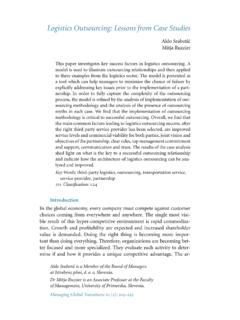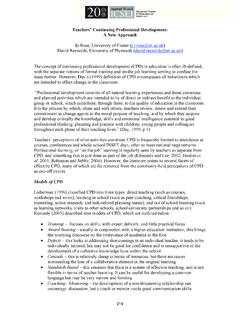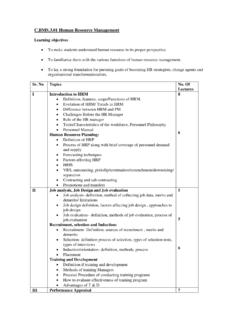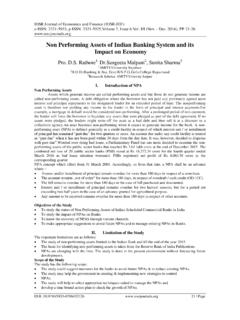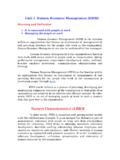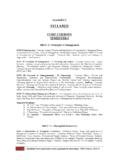Transcription of hrm Practicesin InsuranceCompanies:A Study of …
1 Hrm Practices in Insurance Companies: A Study of Indian and Multinational Companies Subhash C. Kundu Divya Malhan Competitive advantage of a company can be generated from human resources (hr) and company performance is influenced by a set of ef- fective hrm practices. In this Study , we intended to assess the hr prac- tices in insurance companies. Primary data based on 218 respondents from four insurance companies (two multinational-7 branches and two Indian-7 branches) were analyzed to assess hr practices being prac- ticed by insurance companies in India. Six factors from factor analysis were further analyzed. Training and benefits' was found highly in prac- tice in the insurance companies. Further, performance appraisal,' se- lection and socialization of employees,' and hr planning and recruit- ment' were moderately practised in insurance companies.
2 Workforce diversity and contemporary hr practices' and competitive compensa- tion' were also practised to some extent. anova results showed that Indian companies did not practise workforce diversity. Compensation practices were found more competitive or performance based in Multi- national insurance companies than in Indian ones. The gender e ect showed that only competitive compensation was perceived significantly di erently by male and female employees/executives. Interactive e ects were significant on workforce diversity and contemporary issues, train- ing and benefits, and selection and socialization of employees. Key Words: competitive compensation, multinational companies, performance appraisal, selection and socialization, training and benefits, workforce diversity jel Classification: m12, m54, o15. Introduction Under present market forces and strict competition, the insurance com- panies are forced to be competitive.
3 Contemporary companies must seek ways to become more e cient, productive, flexible and innovative, un- der constant pressure to improve results. The traditional ways of gaining Dr Subhash C. Kundu is a Professor at the Haryana School of Business, Guru Jambheshwar University of Science and Technology, India. Dr Divya Malhan is a Lecturer at the Institute of Management Studies, Kurukshetra University, India. Managing Global Transitions 7 (2): 191 215. 192 Subhash C. Kundu and Divya Malhan competitive advantage have to be supplemented with organizational ca- pability i. e. the firm's ability to manage people (Ulrich and Lake 1990). Organizational capability relates to hiring and retaining competent em- ployees and developing competencies through e ective human resource management practices (Ulrich and Lake 1991). Indeed, developing a tal- ented workforce is essential to sustainable competitive advantage (Kundu and Vora 2004).
4 High performance work practices provide a number of important sources of enhanced organizational performance (Pfe er and Veiga 1999). hr systems have important, practical impacts on the survival and financial performance of firms, and on the productivity and quality of work life of the people in them (Cascio 2006). Objectives and Importance of the Study Liberalization in the Indian insurance sector has opened the sector to private competition. A number of foreign insurance companies have set up representative o ces in India and have also tied up with various asset management companies (Shanker 2006). All these developments have forced the insurance companies to be competitive. What makes a firm best is not just technology, bright ideas, masterly strategy or the use of tools, but also the fact that the best firms are better organized to meet the needs of their people, to attract better people who are more motivated to do a superior job (Waterman 1994).
5 In this manner the management of human resources becomes very crucial. Thus, this Study on hrm prac- tices in insurance companies was taken up. The main objective of the Study was to assess the human resource management practices being implemented in insurance companies op- erating in India. To achieve the main objective, the following sub- objectives were set: 1. To assess practices regarding human resource planning and recruit- ment. 2. To identify selection and socialization practices in insurance com- panies. 3. To assess the practices regarding training in insurance companies. 4. To assess practices of performance appraisal in insurance compa- nies. 5. To assess the compensation and benefits related practices in insur- ance companies. Managing Global Transitions hrm Practices in Insurance Companies 193. 6. To identify the workforce diversity and contemporary hr practices being implemented in insurance companies.
6 7. To assess and compare the hr practices being implemented in In- dian and Multinational insurance companies. 8. To assess the di erences of perception of male and female employ- ees regarding hr practices being practiced in insurance companies. 9. To assess the interactive e ects of type of insurance companies and gender on hr practices. Literature Review The literature review regarding various hr practices is presented in the following paragraphs. Job analysis is the process of obtaining information about jobs i. e. in- formation about the tasks to be done on the job, as well as personal char- acteristics (education, experience, specialized training) necessary to do the tasks (Cascio 1998). Job analysis in many ways is the first personnel activity that a ects commitment and performance (Dessler 2003). Hu- man resource planning analyzes and identifies the need for and availabil- ity of human resources for an organization to meet its objectives (Mathis and Jackson 2004).
7 Recruitment is a process of attracting a pool of high quality appli- cants so as to select the best among them (Kulik 2004). Top performing companies devote considerable resources and energy to creating high- quality selection systems (Pfe er 1995). Placement involves assigning a specific rank and responsibility to an employee (Jyothi and Venkatesh 2006). Socialization, the process of orienting new employees to the orga- nization, can make the di erence between a new worker's feeling like an outsider and feeling like the member of the team (Gomez-Mejia, Balkin and Cardy 2003). The current challenges caused by the globalisation pressures in the realm of economics behoves work communities to review their personnel training and management practices (Pitkanen 2007). Companies must develop a customer-oriented workforce to deliver service quality, which is met through training (Kundu 2000).
8 Training must be viewed as an important investment for future success (Zeithmal and Bitner 2004). Companies need to provide comprehensive training to the agents in the ways to narrow the gap between clients and agents i. e. trust building training (Law, Wong, and Theresa 2005). Long-term basis training has Volume 7 Number 2 Summer 2009. 194 Subhash C. Kundu and Divya Malhan a systematic influence on the improvement of management techniques (Zadel 2006). Performance is defined as the record of outcomes produced on a spec- ified job function or activity during a specified time period (Bernardin and Russell 1993). E ective managers need to incorporate performance review and feedback as part of their day-to-day communications with employees (Webb 2004). Appraisals are used widely for tying pay to performance (Schellhardt 1996; Cleveland, Murphy and Williams 1989).
9 Present day firms are facing increased pressure to create human resources policies and programs that avert discrimination against individuals on non-work related aspects with respect to the various functions within human resource management, particularly selection and performance appraisal (Lillevik 2007). Compensation is all forms of financial returns and tangible services and benefits employees receive as part of an employment relationship (Milkovich and Newman 1999). An e ective set of choices about com- pensation systems plays a major role in determining firm performance (Dreher and Dougherty 2005). A fringe benefit is an indirect reward given to an employee or group of employees as a part of organizational membership (Mathis and Jackson 2004), which a ects performance and retention of employees. Benefits planning are a critical component of hr planning processes on account of enormous costs and the financial com- mitment made for the future (Bernardin and Russell 1993).
10 A pay-for- competence program enhances productivity and product quality, and reduces absenteeism, turnover, and accident rates (Jyothi and Venkatesh 2006). A Human Resource Information Systems (hris) is basically a data base system that o ers important information about employees in a cen- tral and accessible location that, when needed, could be retrieved and used to facilitate human resources planning decisions (Wolfe 1998). Ko- vach and Cathcart (1999) noted that hris information could be used, first, for administrative purposes which reduce costs and time and, sec- ond, for the more analytical decision support. A career comprises of series of work related activities that provide continuity, order, and meaning to a person's life (Schein 1996). Career management includes both organizational actions and individual e orts aimed at setting career goals, formulating and implementing strategies and monitoring the results (Greenhaus 1987).





